The Indian football team’s recent triumphs in the Tri-Nation Series, Hero Intercontinental Cup, and SAFF Championship have ignited a wave of positivity and excitement. It’s not just about their historic victory against Lebanon, ending a drought since 1977, but the incredible style in which they achieved it.
Thanks to the fearless approach instilled by head coach Igor Stimac, the players have stepped up their game. With a clear tactical blueprint, Indian football seems poised for a decisive year.

Though there’s still progress to be made, the Blue Tigers boast a settled lineup with improving player combinations, solidifying their identity for upcoming top-tier competitions.
Now, let’s dive into an in-depth tactical analysis of Stimac’s system, their possession and structure, and the intriguing attacking patterns that define their game. Get ready for an exciting exploration of India’s football evolution!
Read More: Som Kumar, 18 Years Old Indian Prodigy shares reasons for choosing Europe over ISL
India’s Shape and Buildup During Possession
When India takes charge of the ball, their tactical prowess comes to life under the guidance of the brilliant Igor Stimac. Facing lower-ranked opponents, Stimac unleashes the attacking might of a 4-3-3 formation, with one defensive midfielder anchoring the midfield.
However, Stimac’s adaptability shines through as he seamlessly switches to a 4-2-3-1 structure, employing two deep-lying midfielders to add a new dimension to the team’s play. Anirudh Thapa and Jeakson Singh are the favored choices for these roles, while the talented Sahal Abdul Samad takes the reins as the central figure behind the striker.

Stimac’s strategic brilliance extends to the defense as well. During the Hero Intercontinental Cup, he seems to have found the perfect back four, combining Sandesh Jhingan’s commanding presence and Anwar Ali’s exquisite passing skills, vital for the team’s ball progression. On the left flank, Akash Mishra’s phenomenal growth has seen him claim the position of India’s undisputed first-choice left-back, impressing fans and critics alike.
While competition sizzles on the right-back front, it is Nikhil Poojary, a former teammate of Mishra, who stands out with his impressive performances in the Intercontinental Cup, securing his spot in the heart of the team’s defense.
Moving forward, India’s attack is nothing short of electrifying. Lallianzula Chhangte, who had a scintillating season in the Indian Super League, has locked his position on the right wing, becoming a force to be reckoned with in the attacking third. On the other flank, a fierce competition ensues among Naorem Mahesh Singh, Ashique Kuruniyan, and Nandhakumar Sekar, all eager to make their mark and contribute to the team’s goal-scoring exploits.
What truly sets India apart is their adaptability during settled possession. Despite starting with a 4-2-3-1 formation on paper, Stimac’s tactical masterstrokes come into play during games against Mongolia and Lebanon. Here, the defensive midfielder, Jeakson Singh, drops deeper alongside the center-backs, forming a dynamic back three. This strategic shift allows the full-backs to venture forward, providing width and giving the team an added edge in the attacking phase.
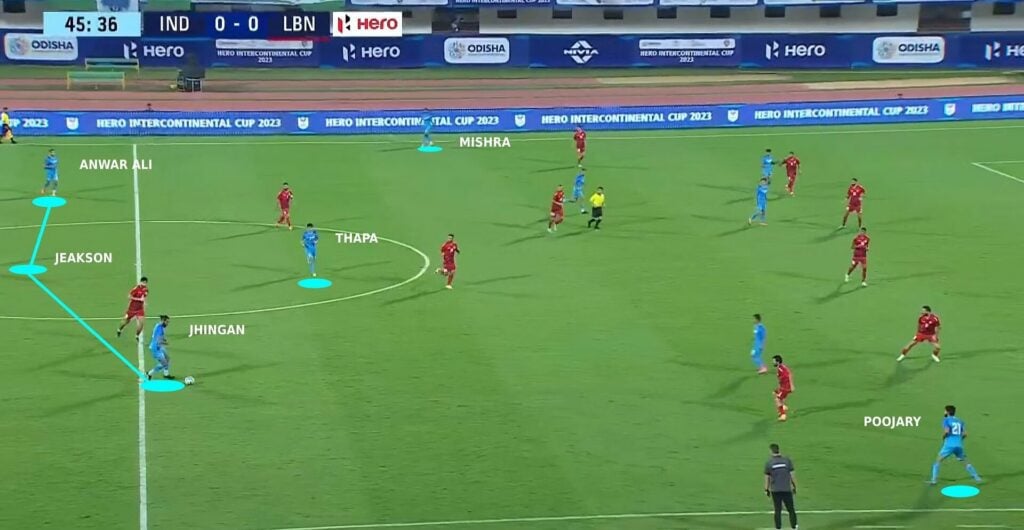
Also Read: Indian Football Team’s Road to Glory: 2026 World Cup Qualifiers Schedule and Chances
Attacking Specimens of India
India’s attacking patterns are a testament to Coach Stimac’s tactical acumen and the players’ adaptability on the field. The team’s approach to possession and buildup is dynamic, providing a thrilling spectacle for football fans.
One of the key elements of India’s attacking strategy is the adventurous nature of their full-backs. When India has the ball, the full-backs take on an offensive role, pushing higher up the pitch. This triggers a chain reaction in the team’s positioning, as the wingers seize the opportunity to occupy the half-spaces between the opposition’s center-back and full-back.
This movement is not just a simple shift in position; it effectively creates a front six, adding an overload in the attacking third. The numerical advantage proves particularly effective against teams that defend with a back four, as it stretches the opposition defense and creates gaps for India’s attacking players to exploit.
A vivid example of this pattern can be seen in a scenario where Anirudh Thapa positions himself near the halfway line, giving room for Akash Mishra to surge forward from the left-back position. In response to Mishra’s advancement, Ashique Kuruniyan intelligently drifts inside to take up a position between Lebanon’s defenders.
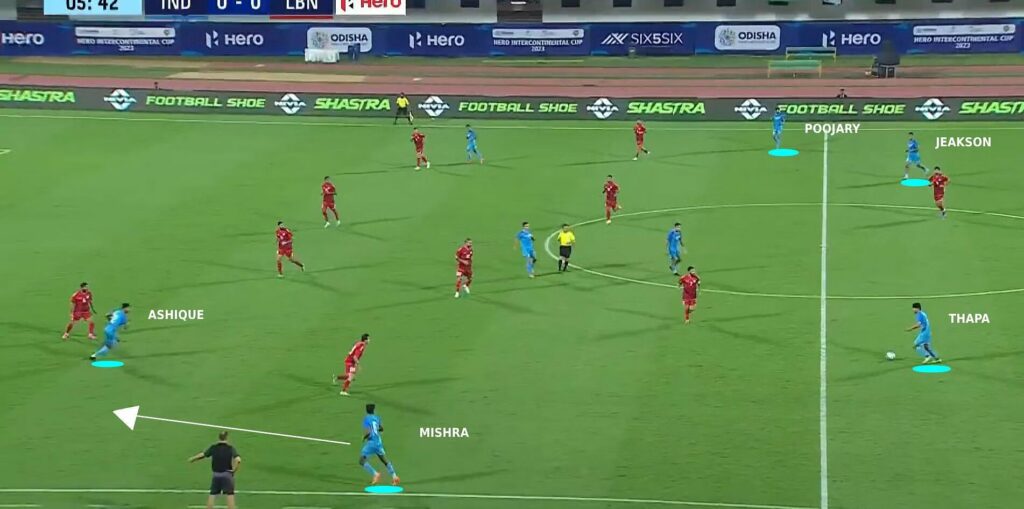
As Kuruniyan cleverly shifts to the blindside, he adeptly evades his marker and makes a well-timed run behind the opposition’s defensive line. Mishra spots the opportunity and plays a perfectly timed through ball to set up Kuruniyan for a clear goal-scoring opportunity. Meanwhile, Lallianzula Chhangte launches a well-coordinated move from the right flank, positioning himself to be available for a cross, thus adding another layer of threat to the attack.
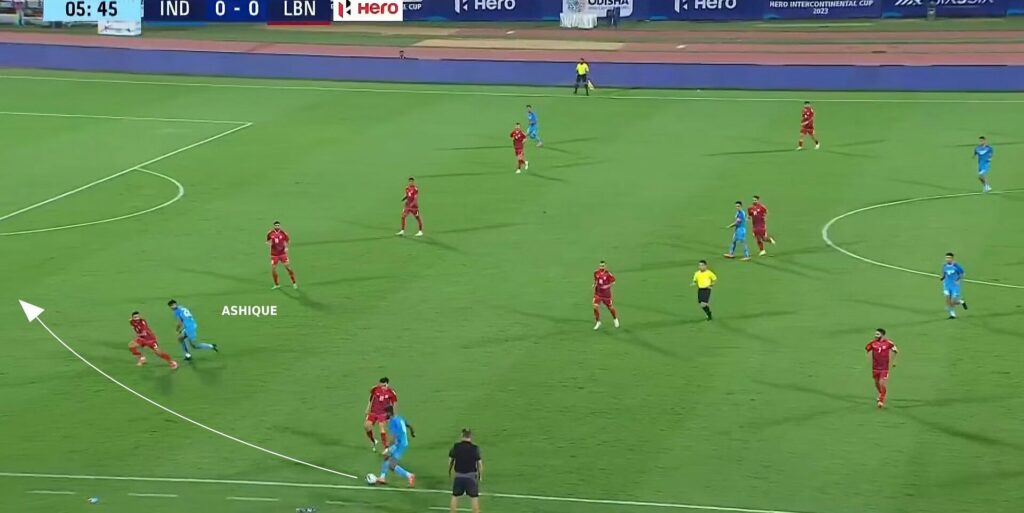
This attacking pattern is further enhanced by the presence of quick and intelligent wingers in the likes of Udanta Singh, Naoram Mahesh Singh, and Ashique Kuruniyan. Their ability to read the game and make incisive runs adds a dynamic edge to India’s forward line.
Another integral pattern in India’s attacking play involves the movement of the attacking midfielder, often positioned just behind the striker. In this role, Sahal Abdul Samad demonstrates his creativity and understanding of space by making smart moves towards the ball, receiving it in the gaps between the opposition lines.
The outcome of this intelligent movement is a three-versus-two advantage on the flanks, giving India options to exploit. An illustrative instance is when Thapa has the ball, Sahal positions himself centrally, and Chhangte holds the width on the left.
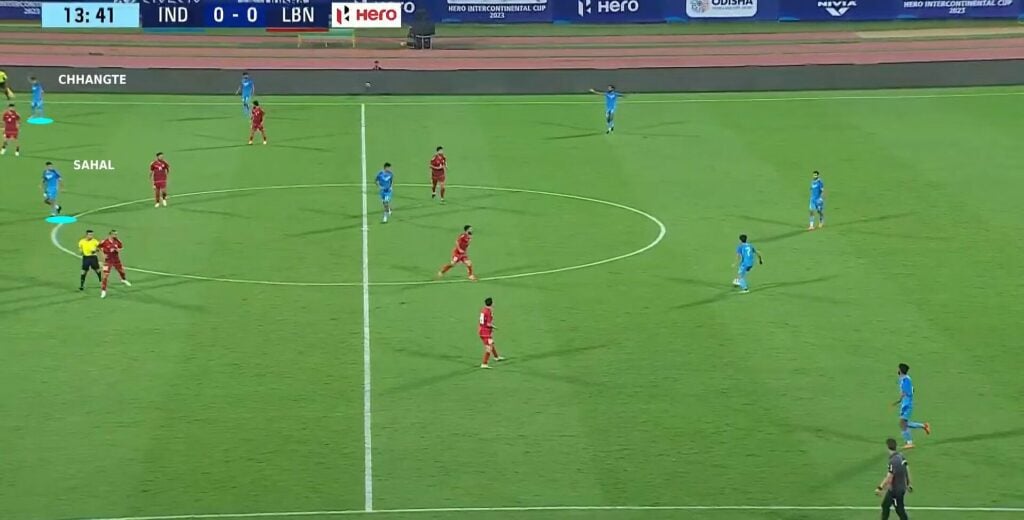
As Thapa eventually passes the ball to Sandesh Jhingan, Sahal swiftly adjusts his position to the right side, linking up with Nikhil Poojary and Chhangte. In this situation, Poojary’s overlapping run creates space for Chhangte to drift inside, allowing Jhingan to play a line-breaking pass, thereby establishing a numerical overload on the flank.
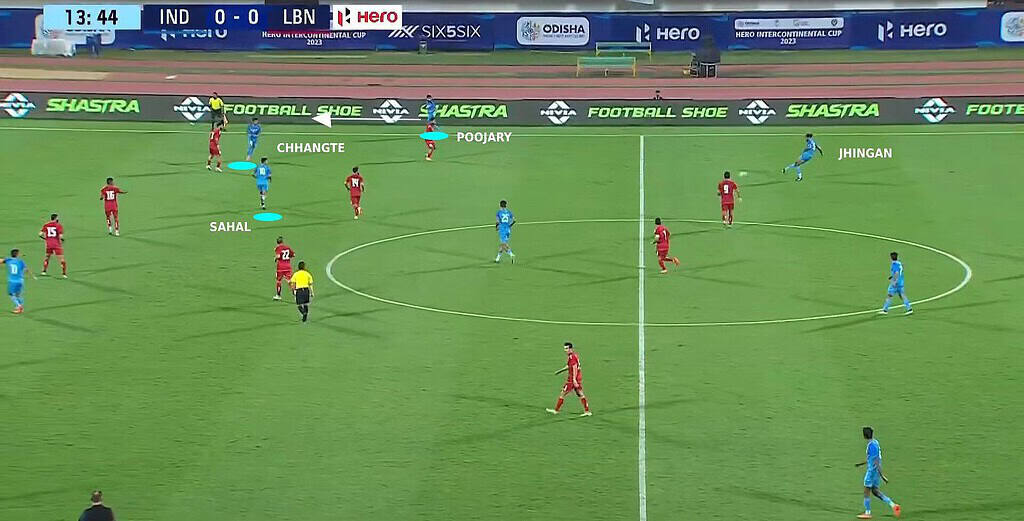
India’s third-man combinations play a vital role in their attacking success, particularly on the right flank. Jeakson Singh positions himself skillfully between the opposition center-backs, while both full-backs are once again high up the pitch. Stimac and Jhingan can be seen instructing Chhangte to move into the half-space and offer himself as a passing option.
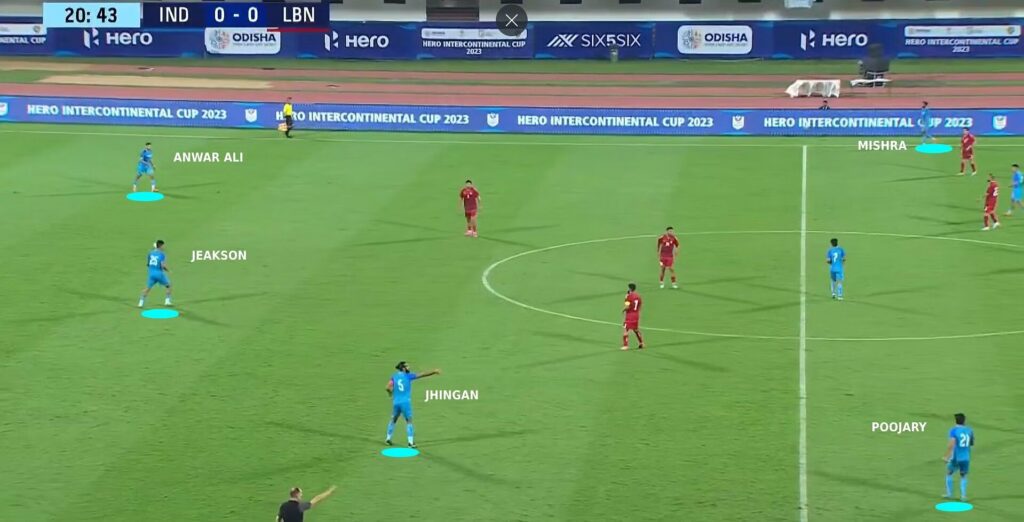
This move effectively pins back the Lebanon wingers and creates space behind them for Nikhil Poojary’s run. As Jeakson releases the pass, Chhangte’s movement draws the Lebanon full-back closer, leading to a corridor of uncertainty in the wide area.
Taking advantage of the defender getting tight to Chhangte, Ashique Kuruniyan, who initially starts as the striker, drops deeper to offer an option. The center-backs fail to track his movement, and Chhangte plays a quick pass to Poojary, initiating a third-man run.
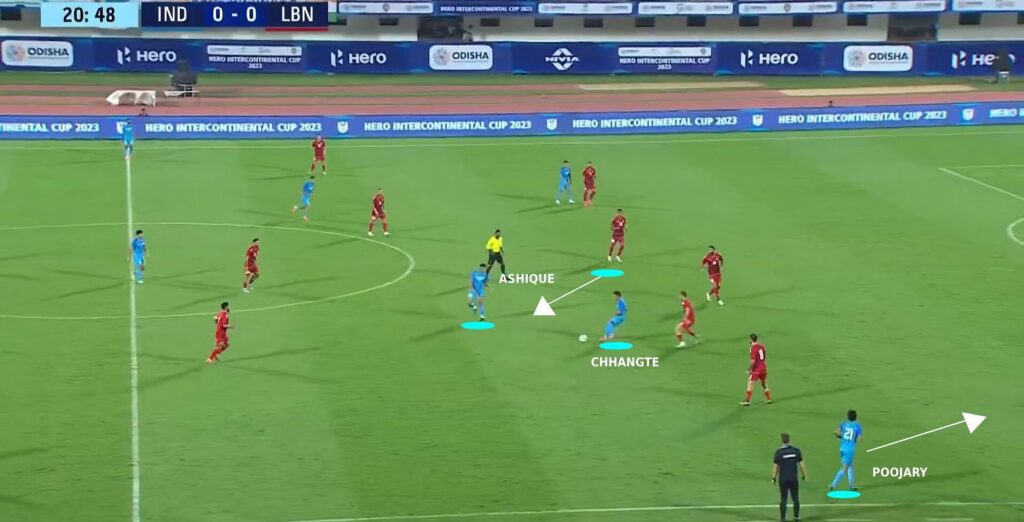
As a result, Ashique receives the ball in space and quickly plays a pass to Poojary. This well-coordinated pattern allows India to have three players attacking the penalty box from the left side, ready to capitalize on any goal-scoring opportunity.
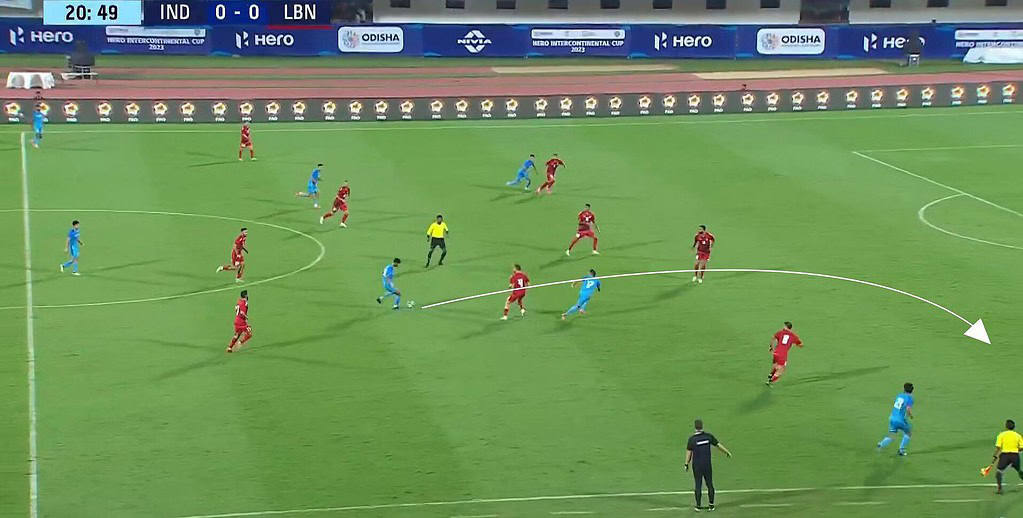
When confronted with aggressive pressing opponents, the Blue Tigers adeptly employ third-man combinations to outmaneuver their adversaries. Thapa and Jeakson form the linchpin of this strategy, orchestrating clever link-ups before involving the advanced full-backs.
Even when Coach Stimac opted to rotate the squad against Vanuatu, the team displayed promising elements, and their well-established attacking patterns and principles remained evident.
In a particular scenario, India flawlessly executed both the ball-sided movement of the attacking midfielder and the third-man combination strategy. The action unfolded as Pritam Kotal, playing as the right-back, skillfully laid off the ball to Mahesh Singh before darting into the space he vacated. At the same time, Liston Colaco, who stepped into Sahal’s position, showcased a well-coordinated ball-sided movement, expertly positioning himself as a passing option for Mahesh.

Continuing the attacking sequence, instead of passing the ball back to Kotal, Mahesh cleverly employs a third-man combination, involving Liston Colaco. Colaco receives the ball and then swiftly plays it back to Kotal, who finds himself in acres of space, thanks to the well-coordinated maneuver.
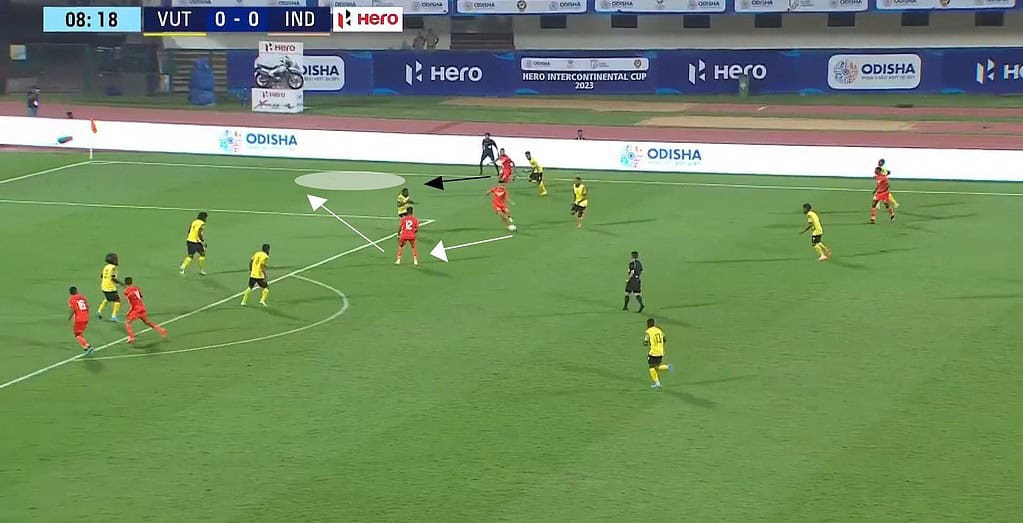
In their attacking approach, India frequently deploys three players inside the opponent’s penalty box, each executing varied and purposeful movements, as illustrated in the image. Notably, the striker and the winger positioned on the far side make runs towards the six-yard box, aiming to attack the space and create goal-scoring opportunities. Meanwhile, Colaco positions himself smartly in the cut-back zone, ready to receive the ball and continue the attacking play if the situation demands it.
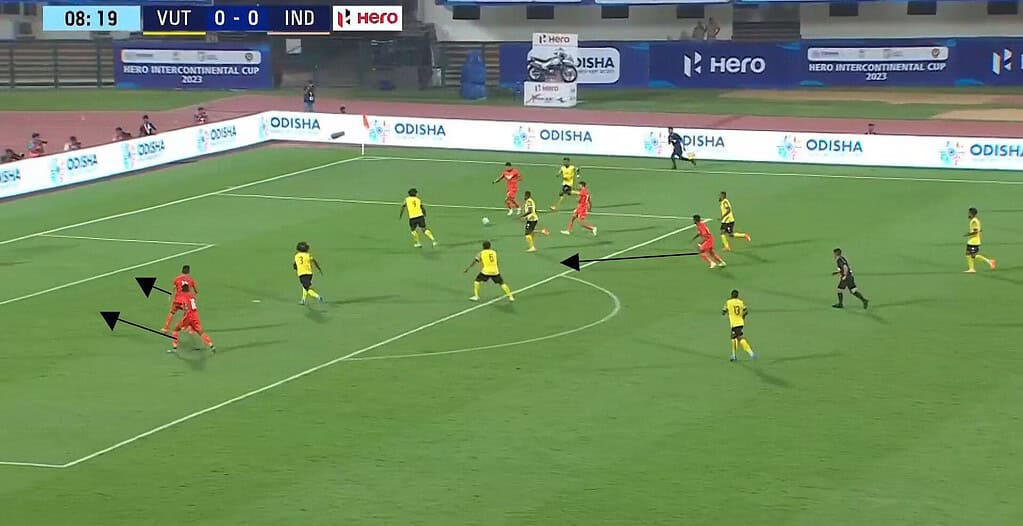
The significance of this attacking pattern lies in its ability to create confusion and unpredictability in the opposition’s defense. With multiple players making intelligent runs and occupying strategic positions, the defenders are left with a challenging task of tracking each movement effectively. The varied movements by the attacking trio often lead to mismatches or unmarked players in dangerous areas, increasing the chances of scoring.
Additionally, the deployment of a player like Colaco in the cut-back zone provides an alternative passing option for the players inside the box. If the defense closes down the central options, the ball can be played out wide to Colaco, who can then deliver a well-timed cut-back pass to one of the onrushing attackers, catching the opposition off-guard.
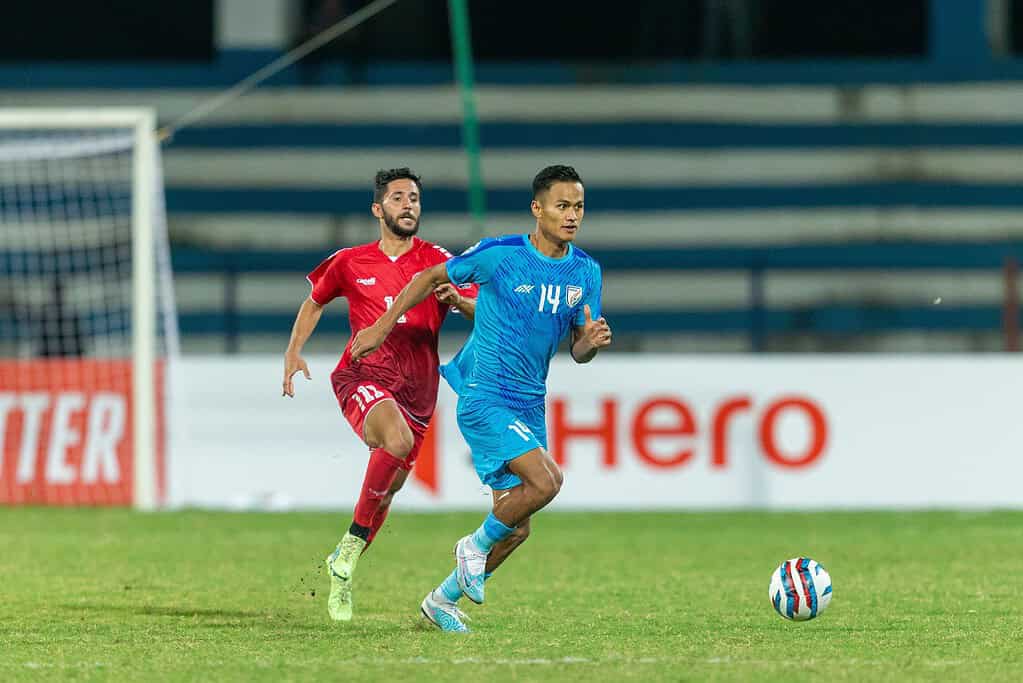
India’s proficiency in executing such attacking patterns highlights their tactical maturity and the players’ understanding of their roles in the offensive phase. This level of coordination and precision comes as a result of extensive training and strategic planning by the coaching staff, led by Igor Stimac.
As India continues to fine-tune their attacking approach, this well-rehearsed and dynamic three-player setup inside the box will undoubtedly serve as a potent weapon, enabling the team to create numerous goal-scoring opportunities and leave their mark on the international football stage. With an array of skilled attacking players and a coach committed to innovation, the future looks bright for Indian football’s attacking prowess. Fans can look forward to witnessing more exciting and imaginative plays from the Blue Tigers as they continue to evolve under Stimac’s guidance.
India’s Defensive Shape and Organization When Not in Possession
Under the guidance of Igor Stimac, India exhibits a disciplined and organized out-of-possession structure, often adopting a 4-4-2 formation. This setup allows the team to remain compact defensively and seamlessly shift across the field when the opponents move the ball wide.
India’s proactive approach is evident in their high-pressing strategy, initiated from the front, aimed at swiftly regaining possession. This aggressive style has proven effective against lower-ranked teams. However, how they respond when facing higher-ranked opponents will be an intriguing aspect to observe.
When pressing, the team employs a few variations, particularly with the front two players. Typically, the forward line actively engages in covering the opposing center-backs, putting pressure on them and forcing mistakes. Meanwhile, the wingers and central midfielders take on the responsibility of man-marking in the central areas of the pitch, denying the opposition space and time to build from the middle.
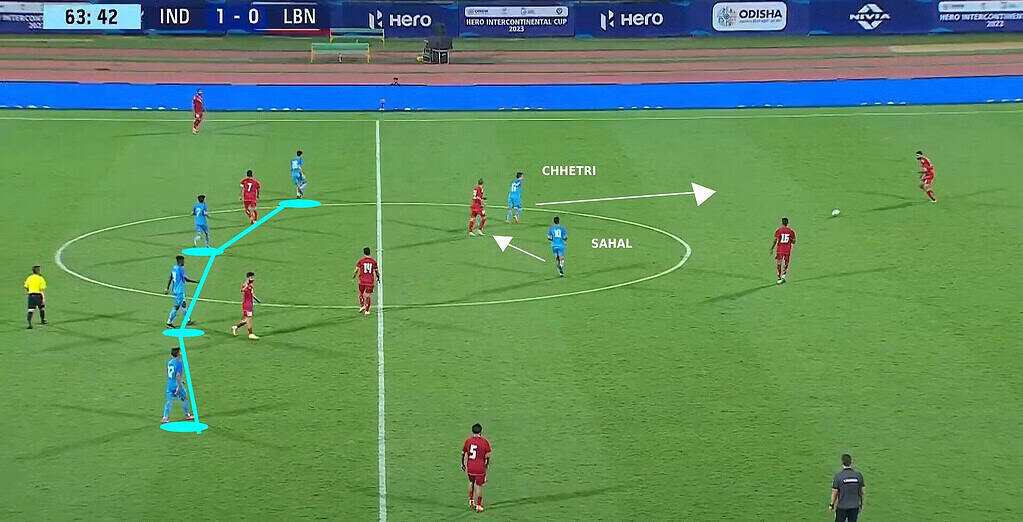
An example of India’s intelligent pressing strategy can be seen in their effective use of the ‘pendulum press.’ In this scenario, Sunil Chhetri applies pressure on the center-back in possession, while Sahal takes on the role of tracking the pivot player in the opposition’s midfield. This strategic positioning effectively restricts central progression for the opposing team, forcing them to either go wide or take longer passes, which increases the likelihood of turnovers.
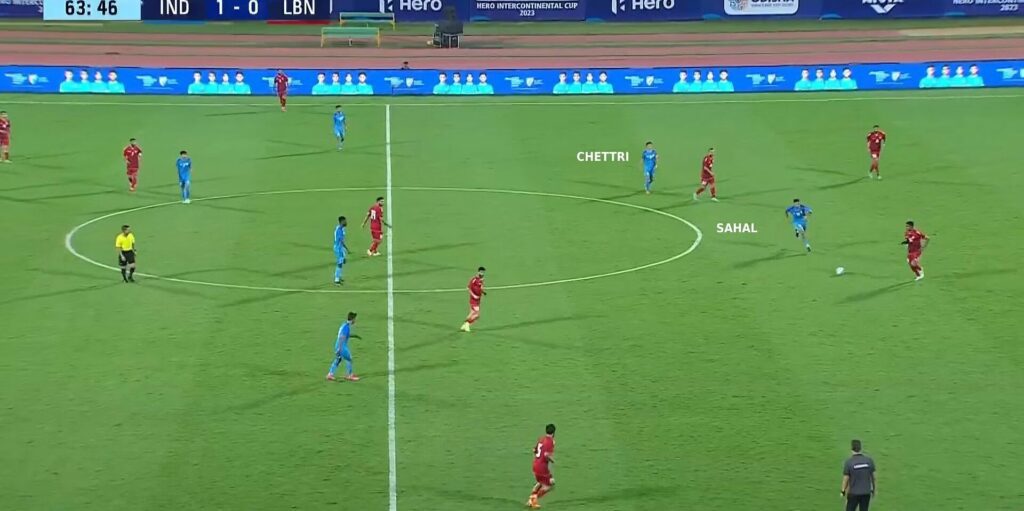
India’s out-of-possession structure exemplifies their tactical awareness and the players’ commitment to fulfilling their defensive responsibilities. Stimac’s emphasis on defensive organization and coordinated pressing enables the team to disrupt the opponent’s build-up play and regain possession in dangerous areas.
With Stimac’s brilliant tactical acumen, a harmonious blend of talent, and a fearless attitude, the Indian football team seems poised to conquer new heights and make a mark on the international stage. Fans can expect enthralling displays and captivating performances as India’s footballing journey unfolds in the upcoming Asian Games 2023, AFC Asian Cup and the World Cup Qualifiers namely.
As India continues to evolve and face tougher challenges on the international stage, their defensive organization and pressing approach will play a crucial role in determining their success. The team’s ability to adapt and execute their out-of-possession strategies effectively will be pivotal in their quest to make an impact on the global football scene. With the right balance of discipline, aggression, and tactical intelligence, India’s defense can prove to be a formidable force and provide a solid foundation for their attacking flair to flourish.




